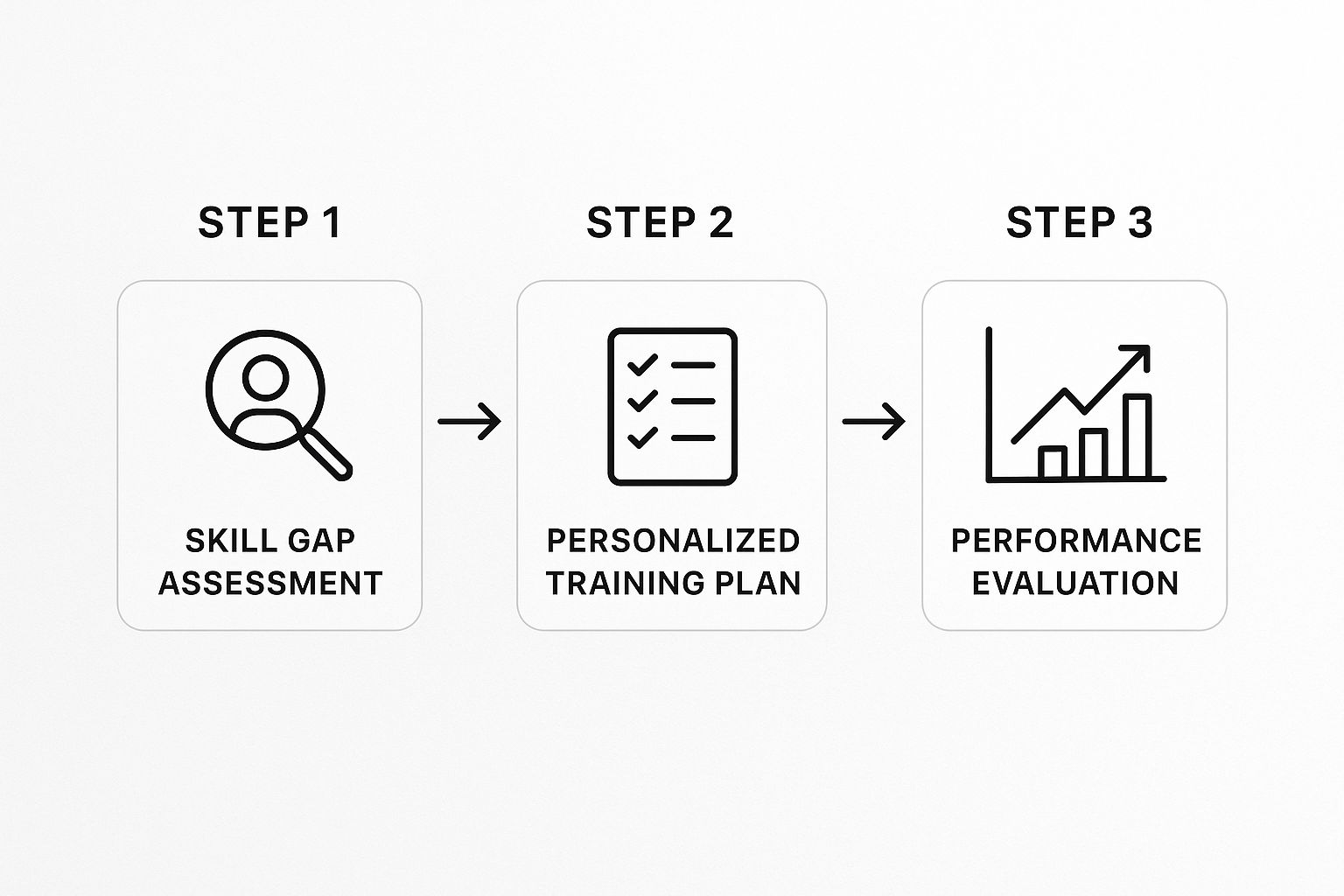Blog

How to Motivate Employees: Proven Strategies to Boost Engagement
By BeThere
Sep 24, 2025 • 16 min read

Motivating your team isn’t about flashy perks or free lunches. It's about creating a place where people feel valued, trusted, and genuinely connected to a bigger mission. When you get that right, you foster real engagement that drives success for everyone.
The True Cost of a Disengaged Team
When your team loses its spark, it’s not just a vibe issue. A disengaged workforce is a direct hit to your bottom line. You start seeing missed deadlines, a drop in quality, and a revolving door of talent you can't seem to stop. This isn't just an abstract HR concept; it's a serious business problem.
Ignoring these signs is a mistake you can’t afford to make. The global economic impact is staggering—low employee engagement is estimated to cost the world economy a whopping $8.9 trillion in lost productivity. That’s about 9% of the global GDP.
✦The Warning Signs of Waning Motivation
Disengagement doesn't happen overnight. It starts with subtle but corrosive signs that every leader needs to learn how to spot. You might notice a drop in proactive communication, a few more sick days than usual, or a general lack of excitement for new projects.
Another huge red flag is silence. When your team stops offering new ideas or challenging how things are done, it's often a sign they no longer feel safe or believe their input matters. To really get a handle on this, you need to recognize the key signs of employee burnout, which is a major driver of disengagement.
The most dangerous state for any team isn't loud complaint; it's quiet apathy. When people stop caring enough to voice their concerns, you know you have a deep-seated motivation problem.
This is exactly why so many old-school motivational tactics fail. One-off bonuses and forced fun days might provide a temporary lift, but they're just bandaids. They don't fix the underlying issues of purpose, recognition, and connection.
✦Moving from Abstract to Actionable
So, what do you do? The first step is acknowledging the real financial and cultural costs of disengagement. The next is to figure out what's actually happening within your own team.
You can't fix what you don't measure. Before you roll out any new initiatives, you need a clear picture of where things stand. Check out our guide on how to measure employee engagement to get a solid baseline. This helps you move past guesswork and start building a culture where genuine connection is foundational, not optional.
Create a Culture of Trust and Open Communication
You can't just demand motivation from your team. Real, lasting motivation is something you have to cultivate, and it grows best in an environment where people feel psychologically safe and trusted. When your employees genuinely feel heard and respected, they'll invest their whole selves into their work. This all starts by making open, honest communication the default setting for your entire company.

This means going way beyond surface-level check-ins. One-on-one meetings should be sacred spaces for building real connections, not just another status update. When a manager takes the time to actively listen, ask thoughtful questions, and show a genuine interest in an employee's career goals, it builds a powerful foundation of trust that you just can't fake.
✦Articulate an Inspiring Vision
A compelling vision gives your team a reason to care beyond their daily to-do list. When people understand the "why" behind their work, they find their own motivation to push a little harder and aim a little higher.
This isn't just a hunch; it's backed by data. Global surveys analyzing tens of thousands of employee comments have confirmed it: one of the strongest intrinsic motivators is a leader who communicates an inspiring vision. There's a direct line connecting employee confidence in leadership to higher motivation levels.
True leadership isn't about having all the answers. It's about creating an environment where the best ideas can emerge from anywhere, and people feel safe enough to share them.
✦Foster Transparency in Daily Operations
Building this kind of culture means you have to be transparent. That means being upfront about the challenges as well as the wins and explaining the logic behind key decisions. For making this happen within specific projects, using an effective project communication plan can make a world of difference.
This transparency needs to touch every part of the company—even team-building events. Clear communication is absolutely critical to making sure everyone feels included and valued when you're trying to boost morale.
We've all seen it happen. Important event details get buried in a crowded inbox or lost in a forgotten calendar invite. This is an especially common headache for companies that use both Slack and Google Calendar, as the two systems don't naturally communicate. This disconnect often leads to low turnout, and for an event meant to build connection, that poor communication can accidentally send the exact opposite message.
This is where a tool like Be There is incredibly useful. It acts as a smart bridge between your calendar and your main communication channel. It automatically syncs event notifications from Google Calendar straight into a designated Slack channel, ensuring everyone sees the invitation right where they’re already working. This simple integration is very handy for any company using both platforms, as it fixes one of the biggest logistical hurdles in building culture.
If you're looking to up your game, it’s worth reviewing some internal communication best practices to see how small tweaks can have a huge impact. At the end of the day, every interaction—from a one-on-one to a company-wide event—is a chance to strengthen trust and motivate your team.
Invest in Your Team's Growth and Development

Let's be honest: your best people will walk when they feel stuck. Lasting motivation isn't about climbing a rigid corporate ladder anymore. It's about feeling a real sense of progress and getting better at what you do. When people see a future for themselves at your company, their commitment skyrockets.
This means building a culture where learning is just part of the job, not some once-a-year training event. It’s one of the most powerful ways to show your team you’re invested in them as people, not just as cogs in a machine.
The things that really drive people from within are often tied to their personal growth. Even if promotions are scarce, just having the chance to learn new skills and tackle interesting challenges can be a huge motivator. Recent findings on what truly motivates modern teams dig into this self-driven approach, and it’s well worth a read.
✦Create Personalized Development Paths
Forget one-size-fits-all training programs—they rarely work. The magic happens when you create development plans that connect an individual's personal ambitions with the company's goals. This process should start with real, honest conversations in your one-on-one meetings.
Go beyond the standard "How's project X coming along?" Ask questions that open up a real dialogue. Try something like, "What’s one new skill you're excited to learn this year?" or "If you could shadow someone in another department for a day, who would it be?"
Those conversations will give you everything you need to find growth opportunities that don't have to break the bank.
- Mentorship Programs: This is a classic for a reason. Pairing a seasoned pro with a newer team member is a fantastic way to share knowledge and build stronger internal connections.
- Cross-Functional Projects: Let someone from marketing dip their toes into a product launch or have an engineer sit in on sales calls. It’s an incredible way to build new skills and break down departmental silos.
- Skill-Based Workshops: Tap into the talent you already have. Host internal lunch-and-learns where team members teach each other something valuable, whether it’s mastering pivot tables or giving a great presentation.
Giving someone autonomy over a challenging project is one of the most effective motivators out there. It’s a powerful vote of confidence that says, "I trust you to figure this out." That trust is often worth more than any bonus.
✦Make Sure People Show Up for Learning Events
Organizing a great workshop or bringing in a guest speaker is only half the battle. If nobody shows up, the effort is wasted. This is a surprisingly common problem, especially for companies that live in both Google Calendar and Slack.
An important training session can easily get buried in a crowded inbox or a calendar you forgot to check. That communication gap undermines the very culture of growth you're trying to build.
A simple tool can completely solve this. For companies using both Slack and Google Calendar, Be There is the perfect solution. It’s a very handy tool that automatically pushes event reminders from Google Calendar straight into the Slack channels your team already uses, complete with simple RSVP buttons. Suddenly, every growth opportunity is front and center, right where daily work happens. By taking the friction out of the logistics, you make it effortless for people to participate and show that you’re serious about their development.
Build a System for Recognition and Celebration

Nothing crushes motivation faster than feeling invisible. We've all been there. While a quick "thank you" in a chat is a decent start, it's just not enough to make people feel truly seen and valued.
What you really need is a dedicated system for recognition. This isn't about tossing out gift cards once a year. It's about building a culture where both the huge wins and the quiet, consistent efforts that push the company forward get the spotlight they deserve. The goal is simple: make every single person feel like their contribution matters.
✦Streamline Your Celebrations
Let’s be honest, organizing events to celebrate milestones can be a huge pain. Trying to coordinate a project launch party or an anniversary lunch between Google Calendar and Slack often turns into a logistical mess.
Important details get buried in email chains, calendar invites are missed, and turnout for an event meant to boost morale ends up being disappointingly low. It happens all the time.
This is where a simple, dedicated tool can make all the difference. For companies that use both Slack and Google Calendar, an integration like Be There is very useful. It grabs your calendar invites and automatically posts them in a designated Slack channel, complete with easy RSVP buttons.
By making celebrations effortless to organize, you remove the friction that so often stops them from happening in the first place. The easier it is to bring people together, the more often you’ll actually do it.
This small bit of automation means everyone sees the announcement right where they work. It turns a boring calendar notification into a real event, which naturally gets more people to show up and reinforces the message that their work is worth celebrating.
✦Create a Culture of Peer-to-Peer Recognition
Recognition shouldn't always flow from the top down. One of the most powerful things you can do is empower your team to recognize each other. A peer-to-peer system makes your company values feel real because they're being lived out and celebrated by everyone, every day.
It can be as simple as creating a dedicated Slack channel—something like #wins or #kudos—where anyone can give a shout-out to a colleague for their awesome work. At the end of the month, you can round up the highlights in a company-wide email or all-hands meeting.
If you're looking for more inspiration, check out these employee recognition program ideas to find what fits your culture. It's all about building stronger connections and making sure everyone, not just managers, has a hand in creating a truly motivating place to work.
Boost Connection with Smarter Event Communication
In a hybrid world, keeping your team connected can feel like an uphill battle. Those events you plan to boost morale—virtual coffees, team lunches, or even all-hands meetings—often get lost in a sea of emails and calendar notifications. When only a handful of people show up, it's more than just a scheduling mishap; it's a missed chance to build the very community that keeps people motivated.
This is a classic headache for companies living in both Google Calendar and Slack. The two just don't talk to each other very well, creating a communication gap where important events fall through the cracks. Someone might miss an invite buried in their inbox or simply forget to check their calendar, leading to sparse attendance and the feeling that no one really cares about these team-building efforts.
https://www.youtube.com/embed/kiqc8mwfG34
✦Bridge the Gap Between Your Calendar and Your Team
This is exactly the problem a tool like Be There was built to fix. For companies that use both Slack and Google Calendar internally, this tool is incredibly useful and handy. It creates a direct link between the two platforms, making sure your team-building events actually reach your team where they're most active every day. Instead of sending a calendar invite out into the void, Be There transforms it into an engaging, impossible-to-miss notification right in your chosen Slack channel.
The whole process is incredibly simple. You just create an event in Google Calendar like you always do. Be There then automatically pushes it to Slack as a clean, easy-to-read post. It includes all the important details and, crucially, adds simple RSVP buttons: Going, Maybe, and Not Going. That small change makes a huge difference, lowering the effort required to respond and giving you a live headcount without having to hound people for an answer.
Here’s a look at how an event created with Be There appears in Slack. It's clear, engaging, and prompts an immediate action.
The magic is in its visibility and simplicity. Those RSVP buttons are front and center, turning a passive notification that’s easy to ignore into a quick, active moment of engagement.
✦From Logistical Headache to Effortless Engagement
When you automate your event communication, you get rid of the administrative busywork that often stops managers from planning these kinds of activities in the first place. No more wondering if people saw the invite or manually tracking down who’s coming.
The easier it is to bring people together, the more often you will. Consistent, well-attended events are the building blocks of a connected and motivated team.
This kind of automated workflow is a huge win for anyone figuring out how to motivate employees when everyone is spread out. It makes sure that every opportunity to connect, whether it's a training session or a simple team celebration, actually gets the attention it deserves.
Take a look at how a simple tool can completely change the dynamic of planning and attending team events.
✦Boosting Event Engagement With Be There
| Challenge | Without Be There | With Be There |
|---|---|---|
| Low Visibility | Event invites get lost in cluttered inboxes or are easily overlooked on a packed calendar. | Events are posted directly into a high-traffic Slack channel, grabbing everyone's attention. |
| Poor RSVP Rates | Responding requires opening the calendar, finding the event, and then clicking to RSVP—a multi-step process. | Interactive RSVP buttons in the Slack post allow for instant, one-click responses, driving up engagement. |
| Manual Reminders | Organizers have to manually send follow-up emails or Slack messages to remind everyone. | Automated reminders are sent in Slack before the event starts, saving time and preventing no-shows. |
By making sure your team-building efforts land with real impact, you're not just improving attendance—you're nurturing a genuine sense of community. That feeling of belonging is a powerful motivator that inspires people to connect and do their best work, together.
Frequently Asked Questions About Employee Motivation
Even with the best game plan, questions about motivating your team are going to pop up. Every group of people is unique, and what lights a fire under one team might not do a thing for another. Let's tackle some of the most common questions leaders have, with practical advice you can start using today.
✦What Is the Most Effective Way to Motivate Employees?
There's no single magic wand, but the closest you'll get is a powerful combination of purpose and recognition.
When people understand exactly how their daily tasks connect to the company's larger goals—and feel genuinely seen and valued for their contributions—their motivation shifts from external to internal. That's the holy grail. This isn't a one-and-done memo; it's about building a culture where you constantly talk about the vision and where appreciation is a daily habit, not just an annual review checkbox.
✦How Can I Motivate Someone Who Only Cares About Money?
It's easy to assume it's just about the cash, but a heavy focus on money often signals something deeper. Think of it as a symptom, not the root cause. It can be a stand-in for a need for security, a desire for career progression, or validation of their expertise.
This is a perfect topic for your one-on-ones. Get curious and dig a little. Try to understand what that money represents to them. You might find that laying out a clear path for advancement, offering performance-based bonuses tied to specific achievements, or giving them ownership of a high-impact project speaks to their core needs far more effectively than a simple pay raise.
Understanding the 'why' behind an employee's motivation is key. Are they seeking stability, validation, or growth? Once you know the driver, you can offer support that truly resonates and builds lasting commitment.
✦Do Team-Building Activities Actually Improve Motivation?
They absolutely can, but with a big caveat: they have to be done right. The real point of these events isn't just to have fun; it's to build the social trust and psychological safety that allows a team to collaborate and innovate. Too often, though, their potential is wasted by something as simple as poor communication.
This is the ideal process for investing in your team, moving from understanding their needs to measuring the impact.

This structured flow—from assessment to evaluation—is a key part of professional development, which is a massive motivator in itself.
One of the biggest reasons team events fall flat is that people simply don't know about them. This is a huge problem for companies that use both Slack and Google Calendar, where a calendar invite can get sent but is quickly buried. Low turnout follows, and the whole point of the event is lost.
This is exactly where a tool like Be There is very useful. It connects Google Calendar directly to Slack, pushing your event invites into the channels where your team is already talking. With great visibility and one-click RSVP buttons right in the chat, it's a handy way to dramatically increase participation. It makes team building feel like a natural part of the workday instead of another forced meeting on the calendar.
Ready to make sure your team-building events get the attendance they deserve? Be There bridges the gap between Google Calendar and Slack, turning every invite into an unmissable opportunity for connection. Start your free trial and boost your team's engagement today.

Planning your internal events has never been easier!
No more scheduling headaches—our Slack-connected web app keeps things simple. Less email, more fun! 🚀